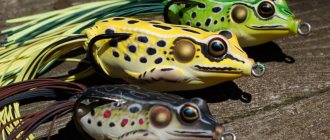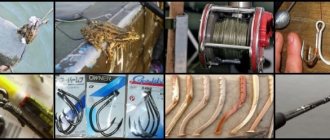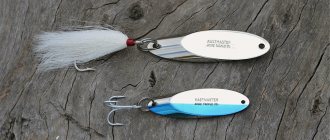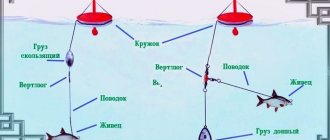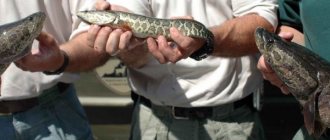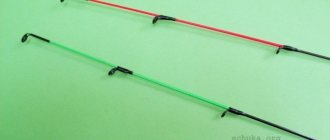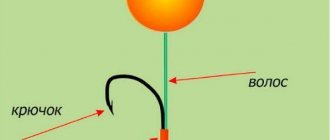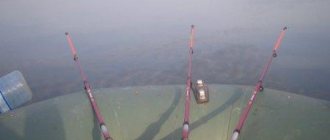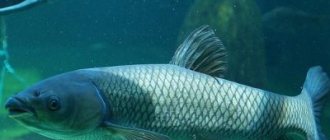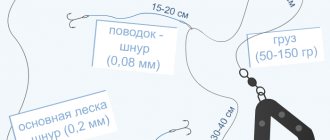Lucky were those fishermen who met such a fish as a snakehead in their lives. The snakehead is unlike any other fish - it is a unique inhabitant of reservoirs with a very impressive appearance. In fact, the snakehead looks more like a reptile than a fish. Catching a snakehead is still different from catching other fish. This is not at all surprising, because such an unusual fish simply must have a special approach to fishing. This means we need to figure out how to catch a snakehead, what needs to be done for this and what to follow when catching it. Since the snakehead is a very aggressive and strong fish, you must prepare yourself both mentally and physically to catch it. You must have good tackle with which you can withstand the power of the snakehead and force it to give up after a bite. In this article we will look at the most effective way to catch snakeheads - spinning fishing with surface artificial baits.
Where to catch snakehead
Snakeheads are common in hot countries and warm fresh waters. Its main habitats are Africa, East and South Asia, a fairly common fish in Kazakhstan, where it was introduced artificially, but took root quite successfully. It is inhabited in some southern water bodies of the CIS countries, including Ukraine - the Dnieper basin and the Ros River, but the snakehead does not really take root in “foreign”, not hot enough places and you need to look for it in warmer countries. As for Russia, fishermen go for snakeheads to Kazakhstan or to the border with China, to the banks of the Amur. Snakeheads love ponds with slow water exchange that warm up well. He likes shallow areas of the reservoir, especially when the water is well warmed up; he loves overgrown backwaters and changes in depth. The first place to look for snakeheads is in weedy, shallow waters with a muddy bottom. The snakehead attacks bait floating on the surface of the water, which is why it is often called a surface predator. On the surface of the reservoir you can see how this fish grabs air from the surface and disappears again under water. The fact is that the snakehead has atmospheric respiration and breathes air, although it also has gills. Using such gulps of air, you can detect the location of the snakehead and provide bait in close proximity to the predator. When fishing for snakeheads, you have to throw the tackle into the very thick of the vegetation, and when fishing from a boat, right to the shore, so the accuracy of the cast must be honed. Otherwise, inaccurate casting will often end in getting caught, wasting time and scaring away wary fish. Don’t be afraid to cast into the seaweed or under bushes in the water, because these are the places the snakehead loves. Using surface bait, which we will talk about below, you reduce the likelihood of getting caught on aquatic vegetation to almost zero, and the likelihood of a snakehead biting increases significantly. Snakehead spawning begins around mid-summer. The female and male snakehead build themselves a nest among aquatic vegetation, which can also be seen on the surface of the water. Usually this is a patch of land cleared of vegetation with a diameter of several meters. Such an area is a very promising place for catching snakeheads, because the fish practically does not leave its home, and if it does, it is not far away. The snakehead protects its offspring - the fry and always tries to keep it in sight.
Snakehead fishing areas
Snakehead fishing in our area is Kazakhstan and Amur (border with China). There, the reservoirs were artificially populated with this fish, it took root and began to reproduce successfully. It is also found in Ukraine in the Dnieper River and in the waters of its right tributary - the Ros River.
Natural places of settlement are water bodies of Africa, South and East Asia. This type of fish is found in shallow, warm, stagnant waters. Prefers muddy shallow waters.
It is possible to spot a snakehead visually on the surface of the water when the fish swims up to gasp for air. Despite the gills, this fish has atmospheric respiration.
When to catch snakehead
Like any other fish, the snakehead has periods of biting and non-biting, bad periods for fishing and feeding. The fisherman must know these time periods and be sure to take them into account if he is going to the pond to catch this fish. Snakehead fishing lasts during the warm season - from May to October. In May, snakeheads begin to become more active in the area as the water warms up. The snakehead rushes to well-warmed areas of the reservoir in search of warmth and food. The most active snakehead fishing takes place approximately from 12 noon and lasts until 19:00. In the morning and late evening, snakeheads are also caught, but their activity decreases, along with a drop in air temperature. Snakehead can also be caught at night, and in some reservoirs night fishing for snakehead can be very successful and this predator rushes at the bait with special inspiration. The most favorable period for catching snakeheads is from the beginning of summer to September, and the peak of this activity occurs in the month of August. In August there is a snakehead zhor. This is the best time to catch a predator. Snakehead bites become more and more greedy and furious, and their frequency goes off scale.
Snakehead fishing.
Hello dear readers! We bring to your attention the article Catching a snakehead with a frog. In this article you will learn all the intricacies of catching snakeheads. Snakehead is a very interesting fish, and the process of catching it is no less interesting. If earlier hunting for this fish was possible only in the Far East, now it is possible to meet this amazing snake in the Kuban basins, rivers of Ukraine and in the waters of Asia.
Time and place for catching snakeheads. And the favorite habitats of this predator are places with a muddy bottom and a lot of aquatic vegetation. The most suitable time for catching snakeheads is August. During this period, the predator’s “zhor” is activated. And since this fish loves well-heated water, it should be caught in the daytime, around noon. Bait. bait for catching this predator is, of course, a silicone frog. But here you will have to work a little, so to speak, modify it specifically for this predator. It is necessary to cut off the extra limbs of the frog, as this often causes empty bites. What about the quality of the bait? The frog should be made of very soft silicone and contain durable and high-quality hooks. Since the snakehead has a “steel” grip when biting, hooks should not fail the fisherman at such a crucial moment. If the silicone turns out to be too hard, the fish will simply spit it out, understand that it is a trap and turn around and swim away to go about its predatory business. During the fishing process itself, you need to have bait of different colors with you, because you cannot know what color the snakehead will choose “today.” Therefore, you will need to change colors after a certain period of time and look for a successful one.
The tightness of your bait plays
an There should be no cracks in it, which means it is necessary to carefully examine them for this defect and, if such a problem is detected, seal them with glue.
You should put the bait on through a loop, because then it will be most convenient to remove it or change it to another, and besides, this method of fastening is quite strong and reliable.
To increase the efficiency of fishing, it is worth working out (so to speak, getting used to the bait) casting technique and retrieving technique. Each bait has its own wiring technique, but this is a matter of experience, so I advise you to experiment.
Tackle
Three meeheads are quite strong fish, and accordingly we will need reliable tackle.
As for the rod, everything is quite simple here - to catch snakehead, the test rod must be at least 100 g. Its length should be from 2.7 meters, this will be useful for us to increase the casting range, if we opt for a shorter rod, then The casting range will be much less than with a long one. I would like to note an important point - if you intend to catch snakehead from the shore, then you need to take into account the fact that this fish will not take your bait closer than 30 meters to the shore.
The fishing line for catching snakeheads must be braided and also withstand a weight of more than 40 kg. Such strength of the fishing line is determined by the sharp and very strong bites of this predator and the fact that fishing usually takes place in reservoirs with increased vegetation.
The coil will be quite inertial. But if you still decide to use an inertia-free one to catch snakeheads, then choose one that is stronger and more reliable.
also need to get an extractor; it allows you to carefully remove the fish from the hook without injuring either it or yourself.
If you have never caught a snakehead, but after reading this article you had a similar desire, you should not underestimate the snakehead. This fish is indeed very strong, although not large in size. Try to pay as much attention as possible to preparing for fishing, otherwise you risk being left with nothing!
What to catch snakehead with, bait
The main method of catching snakeheads is spinning. But catching this predator is significantly different from catching other predatory fish - this applies to fishing, bait, and fishing technique. The following artificial baits are used to catch snakeheads: • silicone frogs; • rotating spoons; • vibrotails; • oscillating spoons; • twisters. It is very good to catch snakeheads on the bottom using live bait or pieces of fish, but anglers more often still use spinning rods to catch this fish, so we’ll talk about the best spinning baits. The best bait option for snakeheads is a silicone frog. When guiding, the frog walks from above along the surface of the water, creating a noise that attracts the snakehead. When a fish attacks the bait, it is clearly visible to the naked eye. The snakehead first strikes the bait several times, after which it swallows it. But you can’t rush to hook it—you need to let the snakehead swallow the bait well. To increase the likelihood of hooking, it is necessary to count 20-30 seconds after the snakehead hits the bait and only then make a powerful hook. Then the probability of a snakehead leaving while fishing is practically zero. As for silicone frogs for snakeheads, they also work well in store-bought versions. But some fishermen carry out simple modifications and claim that in this way the effectiveness of the bait increases significantly. What is the modification of this bait? The legs of the silicone frog are cut off, leaving about 1 cm. Since the legs are hollow, the edges of the stumps of the legs need to be melted a little with a lighter, and then squeezed with your fingers so that they stick together, restoring the tightness of the frog. And a small hole is made in the back of the frog to allow air to escape when the snakehead bites. That's all the simple modification. Wiring for such a bait is very simple. After casting, immediately begin to reel in the bait quite quickly, moving it along the surface of the water. When the snakehead strikes for the first time, it is better to reduce the speed of the retrieve so that the predator can grab the bait well.
Snakehead tackle
The snakehead is a very strong fish, its bites and jerks during fishing are very powerful. Therefore, it is advisable to have good, durable tackle when catching this predator. Now we will look at which tackle is best suited for catching snakeheads. Snakehead rod. To catch snakehead you will need a high-quality rod with a weight of 100 grams or more. Although the weight of the bait when catching this fish, of course, will be much less. Such a powerful spinning rod is needed so that the rod can withstand the load when hooking and landing fish. Basically, the snakehead hides in heavily overgrown areas of the reservoir and, after hooking, tries to hide in this grass. Often the only way to bring a snakehead to shore is to forcefully drag it along with the vegetation. A weak spinning rod may not hold up and break even on the first snakehead. The optimal rod length is 2.7 meters. When catching snakehead from the shore, you can use a spinning rod a little more than 3 meters long. With this spinning rod you can deliver bait much further than with a short rod. Coil. Ideally, use a powerful baitcasting reel that can easily cope with strong fish, even of record size. But most fishermen cannot afford such expensive gear, so if your budget does not allow you to purchase a good multiplier, take a powerful spinning reel. Fishing line. When fishing for snakeheads, it is best to use a soft braided line with a breaking load of at least 40 kg. You should not underestimate the power of this fish. If you are lucky enough to pull out a small snakehead on a thinner tackle, you should not hope for a successful outcome when biting a large predator. Instead of a cord, you can use monofilament fishing line, but it is advisable to use fishing line with a cross-section of at least 0.4 mm. Hooks. To catch snakeheads with a silicone frog, spinners or wobblers, non-hook tees are used, which allow you to fish heavily overgrown areas of reservoirs and reduce the likelihood of a snag to almost zero.
Catching a snakehead with a frog
Photo: Evgeny Kuznetsov.
Indeed, for many Russians, Tashkent and Uzbekistan are primarily associated with an abundance of fruit, sun, cotton, bright robes, but not with fishing.
The Aral Sea with two rivers, after a series of various publications with fishing boats sticking out of the desert sand, more evokes sad thoughts about a fishing paradise destroyed by man.
Considering that there are mountains there, that means there must be trout, and the abundance of ditches and ponds suggests the presence of some kind of fish, crucian carp, carp, catfish.
But these are all the thoughts of those people who did not dive deeply into the topic. Because back in the last century during the USSR, a program for stocking water bodies with fish was carried out throughout the country.
In the Southern regions, in the fight against the malaria epidemic, the reservoirs were stocked with gambusia; to combat reeds and grass, first of all, fry of carp (black and white) and silver carp (white and motley) were sent to the Karakum, Amu-Bukhara canals and drinking reservoirs with Far East.
At the same time, the steppe lakes of Kazakhstan were stocked with catfish, pike perch, and carp. And the new settlers settled in well there. There was no doubt that Turkmenistan and Uzbekistan were also in this program; before, everything was done on a large scale, although often ill-considered.
Previously, while corresponding with Sergei Lysenko (a local spinning fisherman - a high-level master of “snakefish” fishing), we were interested in the peculiarities of his fishing: the choice of gear, baits, reels.
Read the material “The white-sided magpie: a miracle of nature”
Again, in addition to the snakehead, I wanted to catch everything that could be caught on a spinning rod - endemic asp (red-lipped or Syrdarya) with red fins or Amudarya (pike-shaped balding asp), trout, catfish.
In the correspondence, the word treble was mentioned among potential trophies. We also included it in the list of desired trophies.
Step one - Cupping sponge.
Early in the morning we stepped off the ramp and happily plunged into the suffocating heat and the warm embrace of our friends. The plan was very simple.
In four days I wanted to embrace the immensity, go everywhere and try everything. But, as you know, this only happens in dreams. The first acquaintance with the sunny country began with a visit to a local attraction - a restaurant specializing in pilaf.
| Photo: Evgeny Kuznetsov. |
Traditional Uzbek hospitality is simply beyond praise. No matter where we found ourselves, or in what company, even unfamiliar taxi drivers behaved not only correctly, but very affably and friendlyly. (Only sometimes, interrupting the conversation, you need to show them the way...)
Immediately after the restaurant, everyone gets into the car and explores the suburban reservoirs. There are a lot of fishermen everywhere, from ditches to reservoirs. But there are few spinners. Most farmers catch snakeheads using ordinary sticks, often carved from reeds or willow branches.
They hook the frog by the paw and drag it along the surface of an irrigation ditch or a clean window among the algae. They had fish on kukan.
But we are interested in larger specimens, like the silicone frog. As it turned out, this entire sightseeing tour along the banks of various bodies of water led us slowly to our goal, to a riffle on a small river or canal.
Read the material “Utilitarian ATV: simple and reliable”
A small stream with clear water and a clear current was exactly the place where the treble was waiting for us.
The Chinese trumpet, a small predatory fish, was brought here as an unexpected companion along with grass carp, carp and silver carp. (By the way, isn’t it also true that we also got the rotan firebrand, the appearance of which was attributed to aquarists?)
It has taken root well in small streams, finding a good food supply in the form of insect larvae, freshwater shrimp and fish fry. In larger bodies of water, it itself becomes the object of hunting for asp, snakehead, catfish and pike perch. And here it was she who found herself at the top of the food pyramid.
But most importantly, after talking with our new friends, I realized that the treble is exactly the desired trophy for a spinning fisherman, when in the spring other predators have not yet recovered from hibernation.
Sergei, who knows the habits of this small predator, was the first to catch the toothy beast.
| Photo: Evgeny Kuznetsov. |
After a short photo session, the fork-sized fish was released back. Having examined its mouth close up, it became clear where the name came from.
In the middle of the upper jaw there is a notch into which a cartilaginous outgrowth with teeth from the lower jaw extends. Here are three lips.
From such a mouth dotted with small teeth in several rows, neither the fry nor the larvae have a chance to break free.
While retrieving, I felt sharp jolts, thinking that the spoon was hitting the protruding stones, and only near the shore I saw a fish pushing the spoon with its muzzle. A couple more retrieves with a slower reeling of the line, and I was finished.
| Photo: Evgeny Kuznetsov. |
The treble came across a small, silver-colored vibrator.
The second one was caught on a milky-white micro-spinner with a black stripe along the spoon. Micro spinners Mepps Aglia 00 with fluff near the hook, does not take, Aglia Long silver color No. 00, then No. 0, no bite, although the fish splashes nearby, grabbing insects.
I take out the most lethal for chub and ide No. 2 Black Fury, black with scarlet dots. Several casts are missed, with green ones - the result is zero. Meanwhile, my friends are dragging fish, retrieving them a meter away from me.
Read the material “Catching a saberfish is not easy”
I return to my micro-spinners and catch several tremors and one small zander from a depth of about thirty centimeters, but from the edge of the far bank.
But the highest level was a treble of a little over two hundred grams. One more fish and we put down the spinning rods.
Behind the snakehead.
The snakehead also came here during the great migration of fish from the Far East. At the same time, Gambusia, a small viviparous fish, very similar to an aquarium guppy, only not so bright, was settled here.
Gambusia was needed to fight the malaria mosquito, or rather its larvae, in ponds. Malaria has always been the scourge of these places. This small fish coped with the task perfectly, and at the same time became an excellent link in the food chain of many local inhabitants.
When we were just getting ready to go fishing. Sergei warned that June is not the best time to catch a trophy snake. At this time he is still standing on the spawn/
While still in the dark, we arrived at some large lake with a wall of reeds near the shore. By the time we pumped up the boat, lowered it, and floated out into the channel, it was already dawn.
In some places the boat passes closely, you have to work not with oars, but with your hands, pulling the boat, holding the hanging stems. And now the windows are open again, the depth is small, no more than a meter and a half.
Sergey makes fast wiring. His little frog literally runs back, barely touching the water. His tactic is to first discover the fish and its resting place. And then, choosing the wiring and pauses, changing the frogs, their size and color, persuade the snake to bite.
Despite his advice, I lead the frog slowly, making smooth jerks and pauses, imitating the movements of a swimming frog. And then the long-awaited “splash”, and my little frog disappeared from the surface almost without a splash. I pause, as Sergei taught, and even let the braid off the spool a little. My nerves are tense, this is my chance.
Read the material “Believe it or not”
The braid begins to move away from the boat by itself, which means he went into the depths. I quickly tighten the clutch sprocket and make a powerful sweep, reeling in the second slack. Eat! The fish swirled underwater. Judging by the sensations, he is not very large, but this does not matter, he is the first snake in the personal record table.
I release him from the hook so that I can continue the photo shoot with a closer view, without the frog. As soon as I took it in my hands, the seemingly lifeless block came to life and turned into a ball of muscles, lubricated with fish mucus, two or three movements of the tail and the sly man gains freedom. Well done! We still have the whole day ahead of us.
But as the day showed, the higher the sun, the less frequent the already infrequent bites.
Every morning we went to different places in search of a trophy kite, but somehow we had no luck. The last fishing morning has arrived, in the evening there will be a farewell table, and in the morning our board will fly towards Moscow.
This small pond was once a cooler for some enterprise, but after the collapse of the country it did not bear the main load. But getting here was not easy, it remained in forbidden territory, and only Eastern traditions and connections helped our organizer take us here.
There is a chance for a big fish, there is no fishing pressure, which means there are fish. And she was here.
Here and there among the carpet of seaweed there were characteristic rises of water when the snake stuck out the tip of its nose to take a breath. (Snakehead is a lungfish). But he refused to peck.
In some places he even knocked the frog from below, as if pushing it away from the window, but all this was with his mouth closed, he did not want to eat. Either he was standing at the nest, guarding the clutch, or the water had not yet warmed up enough, but it didn’t attack and that’s all.
Read the material “A seasoned wolf rescued a she-wolf from captivity all night”
And then something began to stir in Sergei’s grass. A few minutes of waiting and with a large bunch of grass the snake was brought out.
| Photo: Evgeny Kuznetsov. |
And a couple of hours later, a hundred meters from this pond, he took another one. One kite was given to the organizer of fishing on this reservoir. Sergei brought the second one in the evening for the festive table in the form of wonderful sushi.
And all we have to do is adjust our plans for fishing routes and fly to this hospitable city again to raise the bar for personal records for snakeheads.
Evgeny Kuznetsov August 28, 2021 at 12:53 pm
Interesting facts about the snakehead
1. Snakeheads can breathe not only in water, but also in the open air. This breathing feature allows them to migrate between bodies of water overland. 2. A snakehead can live without water for up to 5 days. 3. Snakeheads belong to the order Perciformes. 4. The largest species of this representative of perciformes is Marulius. This snakehead is distributed from India to China and can grow over 1.2 meters in length. 5. The meat of this fish is very tasty. 6. Snakeheads are good parents: the nest with offspring is guarded by both the female and the male. No fish will dare to approach the snakehead’s lair.
Snakehead habitats
The habitat is constantly expanding. Currently, it inhabits the plains of Uzbekistan, Kazakhstan, Uzbekistan, the Far East, some areas of China, India and some states of the USA. The snakehead is a champion in endurance, it can adapt to almost any conditions - if it gets into a body of water, the local fish in it will have a hard time, if, of course, they stay there. It survives without problems in overseas bodies of water, tolerates drought well, buries itself in silt, can breathe air, moves on land from one body of water to another, and can live for almost five days without water or food.
Read! Fishing in shallow waters
